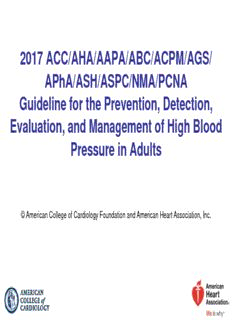
2017 ACC/AHA/AAPA/ABC/ACPM/AGS PDF
Preview 2017 ACC/AHA/AAPA/ABC/ACPM/AGS
2017 ACC/AHA/AAPA/ABC/ACPM/AGS/ APhA/ASH/ASPC/NMA/PCNA Guideline for the Prevention, Detection, Evaluation, and Management of High Blood Pressure in Adults © American College of Cardiology Foundation and American Heart Association, Inc. Publication Information This slide set is adapted from the 2017 ACC/AHA/AAPA/ABC/ACPM/AGS/APhA/ASH/ASPC/ NMA/PCNA Guideline for the Prevention, Detection, Evaluation, and Management of High Blood Pressure in Adults Published on November 13, 2017, available at: Hypertension and Journal of the American College of Cardiology. The full-text guidelines are also available on the following websites: AHA (professional.heart.org) and ACC (www.acc.org) 2017 High Blood Pressure Guideline Writing Committee Paul K. Whelton, MB, MD, MSc, FAHA, Chair Robert M. Carey, MD, FAHA, Vice Chair Wilbert S. Aronow, MD, FACC, FAHA* Bruce Ovbiagele, MD, MSc, MAS, Donald E. Casey, Jr, MD, MPH, MBA, FAHA† MBA,FAHA† Karen J. Collins, MBA‡ Sidney C. Smith, Jr, MD, MACC, FAHA†† Crystal C. Spencer, JD‡ Cheryl Dennison Himmelfarb, RN, ANP, PhD, Randall S. Stafford, MD, PhD‡‡ FAHA§ Sandra J. Taler, MD, FAHA§§ Sondra M. DePalma, MHS, PA-C, CLS, AACC║ Randal J. Thomas, MD, MS, FACC, FAHA║║ Samuel Gidding, MD, FACC, FAHA¶ Kim A. Williams, Sr, MD, MACC, FAHA† Kenneth A. Jamerson, MD# Jeff D. Williamson, MD, MHS¶¶ Daniel W. Jones, MD, FAHA† Jackson T. Wright, Jr, MD, PhD, FAHA## Eric J. MacLaughlin, PharmD** Paul Muntner, PhD, FAHA† *American Society for Preventive Cardiology Representative. †ACC/AHA Representative. ‡Lay Volunteer/Patient Representative. §Preventive Cardiovascular Nurses Association Representative. ║American Academy of Physician Assistants Representative. ¶Task Force Liaison. #Association of Black Cardiologists Representative. **American Pharmacists Association Representative. ††ACC/AHA Prevention Subcommittee Liaison. ‡‡American College of Preventive Medicine Representative. §§American Society of Hypertension Representative. ║║Task Force on Performance Measures Liaison. ¶¶American Geriatrics Society Representative. ##National Medical Association Representative. Applying Class of Recommendation and Level of Evidence to Clinical Strategies, Interventions, Treatments, or Diagnostic Testing in Patient Care* (Updated August 2015) Systematic Review Questions on High BP in Adults Question Question Number 1 Is there evidence that self-directed monitoring of BP and/or ambulatory BP monitoring are superior to office-based measurement of BP by a healthcare worker for 1) preventing adverse outcomes for which high BP is a risk factor and 2) achieving better BP control? 2 What is the optimal target for BP lowering during antihypertensive therapy in adults? 3 In adults with hypertension, do various antihypertensive drug classes differ in their comparative benefits and harms? 4 In adults with hypertension, does initiating treatment with antihypertensive pharmacological monotherapy versus initiating treatment with 2 drugs (including fixed-dose combination therapy), either of which may be followed by the addition of sequential drugs, differ in comparative benefits and/or harms on specific health outcomes? BP indicates blood pressure. BP Measurement Definitions BP Measurement Definition SBP First Korotkoff sound* DBP Fifth Korotkoff sound* Pulse pressure SBP minus DBP Mean arterial pressure DBP plus one third pulse pressure† Mid-BP Sum of SBP and DBP, divided by 2 *See Section 4 for a description of Korotkoff sounds. †Calculation assumes normal heart rate . BP indicates blood pressure; DBP, diastolic blood pressure; and SBP, systolic blood pressure. 2017 Hypertension Clinical 2017 Hypertension Clinical Practice Guidelines Practice Guidelines BP and CVD Risk Coexistence of Hypertension and Related Chronic Conditions Recommendation for Coexistence of COR LOE Hypertension and Related Chronic Conditions Screening for and management of other modifiable I B-NR CVD risk factors are recommended in adults with hypertension. CVD Risk Factors Common in Patients With Hypertension Modifiable Risk Factors* Relatively Fixed Risk Factors† • Current cigarette smoking, • CKD secondhand smoking • Family history • Diabetes mellitus • Increased age • Dyslipidemia/hypercholesterolemia • Low socioeconomic/educational • Overweight/obesity status • Physical inactivity/low fitness • Male sex • Unhealthy diet • Obstructive sleep apnea • Psychosocial stress *Factors that can be changed and, if changed, may reduce CVD risk. †Factors that are difficult to change (CKD, low socioeconomic/educational status, obstructive sleep apnea, cannot be changed (family history, increased age, male sex), or, if changed through the use of current intervention techniques, may not reduce CVD risk (psychosocial stress). CKD indicates chronic kidney disease; and CVD, cardiovascular disease. 2017 Hypertension Guideline Classification of BP
Description: